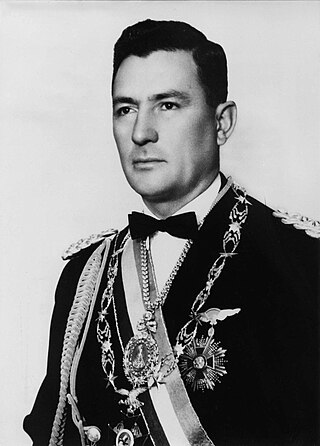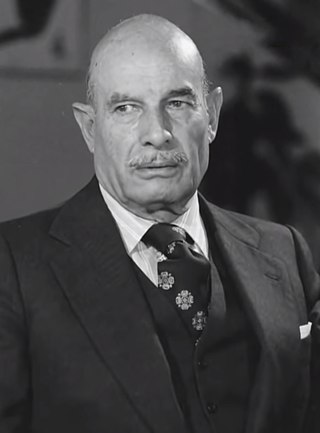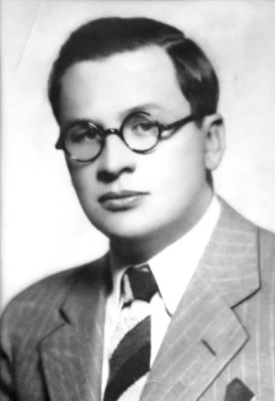Contents
| |||||
| Decades: | |||||
|---|---|---|---|---|---|
| See also: | Other events of 1953 History of Bolivia • Years | ||||
Events in the year 1953 in Bolivia .
| |||||
| Decades: | |||||
|---|---|---|---|---|---|
| See also: | Other events of 1953 History of Bolivia • Years | ||||
Events in the year 1953 in Bolivia .

Carlos Diego de Mesa Gisbert is a Bolivian historian, journalist, and politician who served as the 63rd president of Bolivia from 2003 to 2005. As an independent politician, he had previously served as the 37th vice president of Bolivia from 2002 to 2003 under Gonzalo Sánchez de Lozada and was the international spokesman for Bolivia's lawsuit against Chile in the International Court of Justice from 2014 to 2018. A member of the Revolutionary Left Front, he has served as leader of Civic Community, the largest opposition parliamentary group in Bolivia, since 2018.

The Revolutionary Nationalist Movement is now a centre-right, conservative political party in Bolivia. It was the leading force behind the Bolivian National Revolution from 1952 to 1964. It influenced much of the country's history since 1941.

Gualberto Villarroel López was a Bolivian military officer who served as the 39th president of Bolivia from 1943 to 1946. A reformist, sometimes compared with Argentina's Juan Perón, he is nonetheless remembered for his alleged fascist sympathies and his violent demise.

René Barrientos Ortuño was a Bolivian military officer and politician who served as the 47th president of Bolivia twice nonconsecutively from 1964 to 1966 and from 1966 to 1969. During much of his first term, he shared power as co-president with Alfredo Ovando from 1965 to 1966 and prior to that served as the 30th vice president of Bolivia in 1964.

Hernán Siles Zuazo was a Bolivian politician who served as the 46th president of Bolivia twice nonconsecutively from 1956 to 1960 and from 1982 to 1985. He also briefly served as interim president in April 1952, and as the 27th vice president of Bolivia from 1952 to 1956.

José Enrique Hertzog Garaizábal was a Bolivian politician who served as the 42nd president of Bolivia from 1947 to 1949. He resigned in 1949, and died in exile in Argentina.

Mamerto Urriolagoitía Harriague was a Bolivian lawyer and politician who was the 43rd president of Bolivia, from 1949 to 1951. A member of the Republican Socialist Unity Party, he had previously been the 26th vice president of Bolivia, from 1947 to 1949, under President Enrique Hertzog. Urriolagoitía's short reign was characterized by the violent suppression of the opposition, especially unionists, and he is remembered for his inflexibility. He is considered the last constitutional president of the largely oligarchic social and political order that reigned in the country until the advent of the 1952 Bolivian National Revolution.

Wálter Guevara Arze was a Bolivian statesman, cabinet minister, writer, and diplomat, who served as the 54th president of Bolivia on an interim basis in 1979.

Ñuflo Chavez Ortiz was a Bolivian lawyer and politician. He was 28th vice president of Bolivia during the first Government of Hernán Siles Zuazo since August 1956 till he resigned in 1957. He was one of the founders of MNR, along with Víctor Paz Estenssoro, Wálter Guevara Arze, Carlos Montenegro, Germán Monroy Block and Lidia Gueiler Tejada, amongst others.

The history of Bolivia since 1982 begins with the restorations of democracy after the rule of the military junta of 1982. Evo Morales held the presidency from 2006 to 2019. A new constitution was enacted in 2009. Bolivia's population has roughly doubled over this period, from 5 million in 1980 to 10 million as of 2012.

General elections were held in Bolivia on 1 July 1979. As no candidate in the presidential elections received a majority of the vote, the National Congress was required to elect a President. However, the Congress failed to elect a candidate after three ballots and instead selected Senate leader Wálter Guevara to serve as Interim President for a year on 8 August. Guevara was later overthrown by a military coup led by Alberto Natusch on 31 October. Fresh elections were held in June 1980.

General elections were held in Bolivia on 29 June 1980, the third in three years. As no candidate in the presidential elections received a majority of the vote, the National Congress was required to elect a President on 6 August. With Hernán Siles Zuazo of the Democratic and Popular Union the favourite to win the Congressional ballot, the process was disrupted on 17 July by the military coup led by General Luis García Meza Tejada. However, Meza was pressured to resign on 4 August 1981, resulting in General Celso Torrelio becoming president. In July 1982 he was replaced by General Guido Vildoso, who was named by the high command to return the country to democratic rule. On 17 September 1982, during a general strike that brought the country close to civil war, the military decided to step down, to reconvene the National Congress elected in 1980, and to accept its choice of president. Accordingly, the National Congress revalidated the 1980 election results on 23 September and overwhelmingly elected Hernán Siles Zuazo as president on 5 October. He subsequently assumed the presidency on 10 October 1982.

General elections were held in Bolivia on 14 July 1985. As no candidate for the presidency received over 50% of the vote, the National Congress was required to elect a President on 4 August. Although Hugo Banzer of Nationalist Democratic Action (ADN) received the most public votes, Congress elected Víctor Paz Estenssoro of the Revolutionary Nationalist Movement (MNR).

General elections were held in Bolivia on 6 May 1951. Víctor Paz Estenssoro of the opposition Revolutionary Nationalist Movement (MNR) received the most votes in the presidential election, but as he did not obtain an absolute majority, the National Congress was constitutionally obliged to elect a President on 6 August from the three candidates who received the most public votes. However, on 16 May a military junta assumed responsibility for the Government with Brigadier General Hugo Ballivián as President.

The Bolivian Revolution of 1952, also known as the Revolution of '52, was a series of political demonstrations led by the Revolutionary Nationalist Movement (MNR), which, in alliance with liberals and communists, sought to overthrow the ruling Bolivian oligarchy and implement a new socioeconomic model in Bolivia. Its main leaders were the former presidents Víctor Paz Estenssoro and Hernán Siles Zuazo. The MNR government after this Revolution lasted from 9 April 1952 until the coup of 4 November 1964. In these twelve years, there was a co-government and at the same time a power struggle between the party and the labor unions.
Bolivia has experienced more than 190 coups d'état and revolutions since its independence was declared in 1825. Since 1950, Bolivia has seen the most coups of any country. The penultimate known attempt was in 1984, two years after the country's transition to democracy in 1982. The most recent attempted coup d'état was in 2024, led by General Juan José Zúñiga.

Gualberto Villarroel assumed office as the 39th President of Bolivia on 20 December 1943, and his term was violently cut short by his death on 21 July 1946. A colonel during the Chaco War, Villarroel and the Reason for the Fatherland (RADEPA) military lodge joined the fledgling Revolutionary Nationalist Movement (MNR) to overthrow President Enrique Peñaranda in a coup d'état.

Eduardo Arze Quiroga was a Bolivian scholar, journalist, politician, and diplomat who served as Minister of Foreign Affairs from 1960 to 1962 in the second cabinet of Víctor Paz Estenssoro. Prior to that, he served in various diplomatic offices in the governments of Enrique Peñaranda and Gualberto Villarroel.

Carlos Montenegro Quiroga was a Bolivian lawyer, journalist, politician, and writer who served as minister of agriculture from 1943 to 1944. He was the principal political theorist of the Revolutionary Nationalist Movement, co-founding the party newspaper La Calle which laid the ideological bases of the party. His most famous work, Nacionalismo y coloniaje (1943), an essay on the influence of journalism in the history of Bolivia, is considered to be one of the most influential works in Bolivian historiography.
The following is a list of events in the year 1964 in Bolivia.
Carlos Mesa nació el 12 de agosto de 1953 en la ciudad de La Paz.